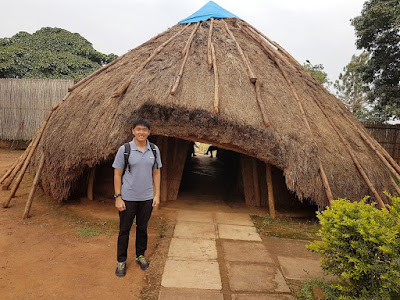Tokyo City, Tokyo, JapanOriginally a fishing village named Edo, Tokyo is the capital city of Japan. It's said that the Greater Tokyo area is the most populous metropolitan area in the world, having approximately than 37.4 millon residents as of 2020. It's, of course, not possible to capture every single part of central Tokyo in two posts, but I shall bring you through some of the places that I passed by during my latest trip there.
---
JPN: Central Tokyo (Part 1) <YOU ARE HERE!>
After arriving at Haneda International Airport, my BFF and I took a train on Tokyo Monorail.
 |
I really enjoyed the fresh cooling air early in the morning, which made me less sleepy after the red-eye flight.
|
 |
The journey to Hamamatsucho railway station took about 20 minutes.
|
 |
| At Hamamatsucho railway station, we changed to another train on Yamanote Line to Shinjuku railway station. |
After slightly less than 35 minutes on the second train, we arrived at Shinjuku, which was quite peaceful before the rush hour.
Here are some photos of the very first sakura (lit. cherry blossom) tree that I saw in person.
 |
I recall spending around 5 minutes trying to capture it from different angles.
|
 |
I posted this photo on my Instagram account, and it got an exceptionally high number of likes.
|
Shinjuku is a special ward of Tokyo, which is a major commercial and administrative centre.
 |
Welcoming spring with open arms!
|
 |
I'm not sure what building is that, but it looks cool.
|
 |
Is that a godzilla?
|
 |
Kabukicho is a famous entertainment and red-light district in Shinjuku.
|
Below are just a few photos of Shinjuku at night. Before you ask, nope, I didn't go to Kabukicho during my latest trip, but I did walk down some of the alleys there back in 2013.
 |
Taito Station always reminds me of not only Space Invaders, but also Bubble Bobble.
|
 |
I had fun exploring the basement level of Takashimaya Times Square.
|
Let's move on to Shibuya, another special ward of Tokyo. The famous Shibuya Crossing was featured in the 2016 Summer Olympics closing ceremony to promote what supposed to be the 2020 Summer Olympics.
 |
It was also featured in a few movies, such as The Fast and the Furious: Tokyo Drift and Resident Evil: Afterlife.
|
Near Shibuya railway station is a memorial statue of Hachiko, a remarkably loyal Akita dog owned by Hidesaburo Ueno. It continued to wait in front of the railway station every single day for over nine years for Ueno to return from work, obviously without knowing of Ueno's sudden passing due to cerebral hemorrhage.
 |
There's an information centre in front of the statue.
|
I managed to retrieve an old photo of a Shibuya community bus that's named after the dog, which stops at various public and community facilities, as well as railway stations within the area.
The current Imperial Palace is located to the west of Tokyo railway station, occupying the former site of Edo Castle. We didn't have the chance to go into the main grounds, so we explored the areas outside of it.
 |
That's one of the preserved gates of Edo Castle that was built in 1457.
|
 |
Such a refreshing evening walk~
|
 |
Admission to the main grounds is free, but you can't roam freely on your own.
You can either register online or do a walk-in for a guided tour, but take note there are limited slots daily. |
At Kokyo Gaien National Garden near the Imperial Palace, there's a statue of Kusunoki Masashige, a Japanese samurai of the Kamakura period remembered as the epitome of loyalty.
Stay tuned for Part 2, which shall cover a little bit more of the area near Tokyo railway station, as well as Odaiba and Asakusa.





















































Comments
Post a Comment